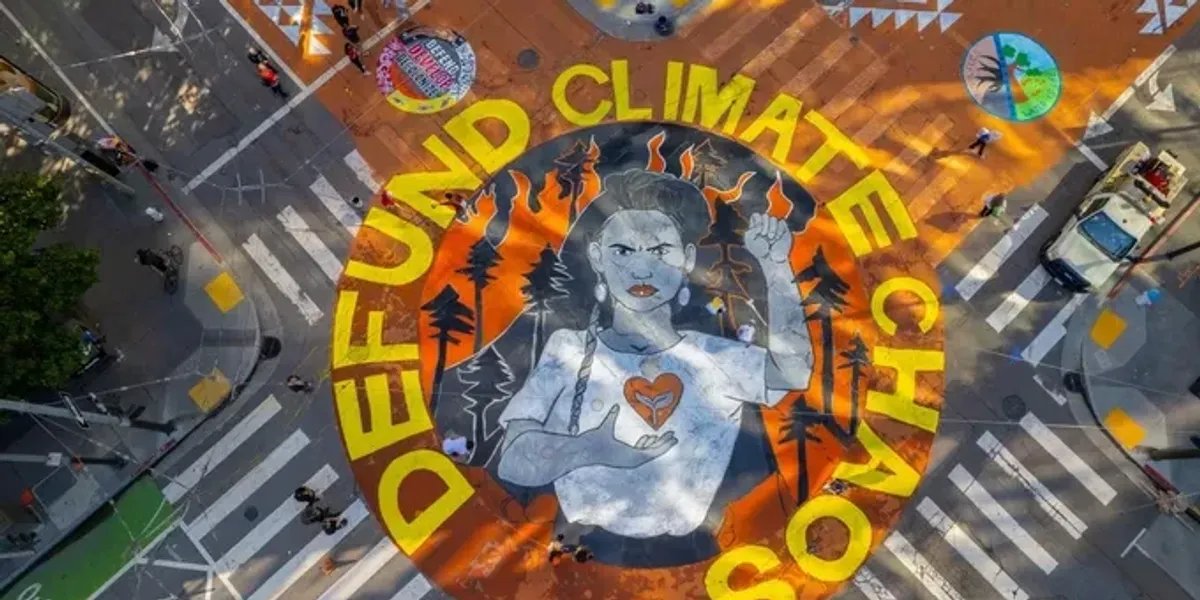
In this country, there are two centers of power large enough to make a real difference in the global climate fight: the federal government and the financial industry. That’s why our coalitions are focused on these two arenas of contestation. People vs Fossil Fuels is a coalition of more than 1,200 organizations demanding President Biden end fossil fuel expansion. Stop the Money Pipeline is a network of more than 240 groups dedicated to ending Wall Street’s financing of the fossil fuel industry.
Now, for the first time, our coalitions are coming together for a shared project: Peoples’ Earth Week - Climate Justice Arts & Action.
Right now, people all over the country are signing up to receive climate justice movement poster art created by leading artists who are involved in movements for justice. Between April 15th and 25th, activists will use the poster art to organize mass wheat pasting actions, pop-up art shows, and arts-centered direct actions. This Earth Day will be the biggest day of coordinated climate arts-based action.
Peoples’ Earth Week builds on a long history of social movements centering arts and culture. Freedom songs were the soul and lifeblood of the civil rights movement, sung in meetings, at sit-ins, and in jail houses. Poetry played a key role in the fight for women’s liberation in the 1960s, helping to bring countless women into the struggle. In the 1980s, ACT UP brilliantly used graphic arts and direct action to help win changes that saved millions of lives.
This Earth Day will be the biggest day of coordinated climate arts-based action.
As with so many other struggles for liberation, arts and culture are a key front in the fight to end environmental racism, protect Indigenous rights, and rein in the climate crisis. This is never clearer than when art is used as a form of direct action, as the climate movement has done increasingly well in recent years. In San Francisco, activists have shut down the financial district to paint block-long murals. In Seattle, bank branches have been redecorated in the dark of night. In New York, activists have placed thousands of stickers onto Citi-sponsored rent-a-bikes and held “eat the rich” banquets in the doorways of billionaires.
Wheatpasting a poster onto a bank branch or placing a sticker on an ATM may not feel like a direct way to address the climate crisis, but movements are made up of millions of such small actions, actions that taken together chip away at harmful, oppressive systems and help to contribute to a new zeitgeist. We may not have the money to take out million-dollar TV ads, but we have the power to blanket the nation in posters and stickers that shine a light on the White House’s role in greenlighting new oil and gas projects and Wall Street’s financing of those projects.
Of course, activists should be aware that there is some legal risk that comes with wheatpasting, especially if you’re wheatpasting onto a bank or a government building. They should also be aware that the level of risk varies from state to state, and city to city. But no movement has ever won real change without a dedicated base of thousands of people who are willing to take risks great and small. If it were not for the countless thousands who overcame fear and took risks women might still not have the right to vote and segregation might still be the law of the land.
We’ve chosen to focus on Earth Day for this action for a reason. In 1970, an estimated twenty million people took to the streets for the first Earth Day. It was a watershed moment in this nation’s history. Two months later, the Environmental Protection Agency was formed and over the subsequent years a litany of bedrock environmental laws were passed, including the Clean Air Act, the Clean Water Act, and the Endangered Species Act.
Since then, however, Earth Day has too often been co-opted by corporate forces. Major corporations use Earth Day as an opportunity to put out empty statements and greenwashed marketing, even as they continue to fund fossil fuel expansion and exacerbate environmental racism in communities of color. The President of the Wells Fargo Foundation ― the “charitable” arm of the world’s largest funder of fracking ― even sits on the board of the official Earth Day organization.
What better way to reclaim the radical roots of Earth Day than by simultaneously making the world a more beautiful place, and exposing those who are truly responsible for the climate crisis?
This content originally appeared on Common Dreams and was authored by Alec Connon.